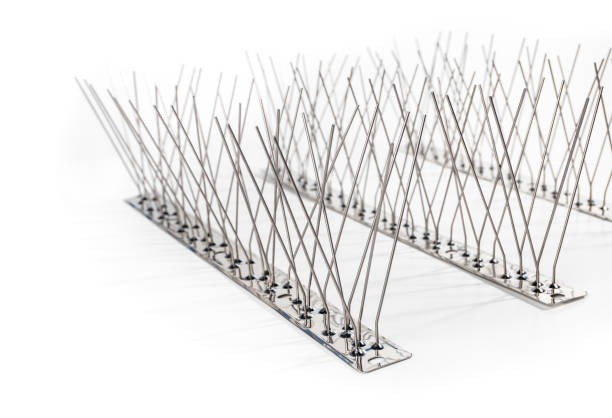I. Introduction
A. Definition of bird spikes
Bird spikes are physical devices designed to deter birds from landing or roosting on structures such as buildings, ledges, and signage. They consist of thin, pointed rods or spikes that are usually made of durable materials like stainless steel or plastic.
B. Brief explanation of their purpose
The primary purpose of bird spikes is to prevent birds from perching or nesting in unwanted areas. By creating an uneven and uncomfortable surface, bird spikes discourage birds from landing, roosting, or nesting, thereby reducing property damage, health risks, and other problems associated with bird infestation.
II. Bird Control Challenges
A. Overview of the problems caused by birds
Birds can cause numerous issues in various settings. They may damage structures, create unsightly droppings, spread diseases, contaminate food supplies, interfere with machinery, disrupt communication signals, and pose safety risks near airports.
B. Impact on various industries and environments
Birds can affect a wide range of industries, including agriculture, manufacturing, hospitality, and transportation. They can also disrupt natural habitats, endanger native species, and impact ecosystems.
C. Difficulty in deterring birds effectively
Traditional methods like scare tactics, netting, and chemical repellents are often ineffective in the long term. Birds quickly adapt to these measures, making bird control a continuous challenge.
III. Functionality of Bird Spikes
A. Description of bird spikes and their design
Bird spikes typically consist of rows of closely spaced, pointed rods or spikes. They are designed to be easily installed on various surfaces, including ledges, signs, beams, and rooftops.
B. How bird spikes work as a deterrent
When birds attempt to land on a surface fitted with bird spikes, they are met with an uncomfortable and unstable perch. The spikes prevent birds from finding a stable footing, forcing them to seek alternative locations without spikes.
C. Advantages over other bird control methods
Bird spikes offer several advantages over alternative bird control methods. They are low-profile, visually unobtrusive, long-lasting, and do not harm birds. Furthermore, they can be easily installed and require minimal maintenance.
IV. Benefits of Bird Spikes
A. Prevention of property damage
Bird droppings can cause extensive damage to structures, vehicles, and machinery. Bird spikes help protect these assets by deterring birds from perching and nesting, thereby reducing the risk of corrosive droppings and associated repair costs.
B. Protection of public health and safety
Birds and their droppings can harbor various diseases and parasites, including bacteria, fungi, and ectoparasites. By preventing birds from congregating in public areas, bird spikes reduce the risk of disease transmission to humans and animals. Additionally, bird spikes discourage birds from nesting near electrical equipment, reducing the chance of electrical fires or disruptions.
C. Preservation of architectural structures
Historical buildings, monuments, and structures with intricate architectural details are particularly vulnerable to bird damage. Bird spikes help preserve the aesthetic and structural integrity of these landmarks by preventing birds from perching and nesting.
D. Conservation of natural habitats
Birds may invade and disrupt natural habitats, leading to displacement or endangerment of native species. By deterring birds from nesting in inappropriate areas, bird spikes contribute to the conservation of natural ecosystems and protect indigenous wildlife.
V. Bird Spikes Applications
A. Commercial and residential buildings
Bird spikes can be installed on ledges, rooftop edges, balconies, and window sills of both commercial and residential buildings, preventing birds from roosting or nesting in these areas.
B. Agricultural and industrial facilities
Farms, agricultural fields, warehouses, and industrial facilities are often vulnerable to bird damage. Bird spikes can be used to protect crops, livestock, stored goods, machinery, and equipment.
C. Public spaces and landmarks
Parks, plazas, statues, and public monuments are commonly targeted by birds. Bird spikes can help maintain cleanliness and preserve the aesthetic appeal of these public areas.
D. Transportation infrastructure
Airports, train stations, bridges, and other transportation infrastructure can be heavily affected by bird presence. Bird spikes can be deployed to prevent bird collisions with aircraft, damage to vehicles, and interference with signal systems.
VI. Environmental Considerations
A. Non-lethal and humane nature of bird spikes
Unlike some bird control methods, bird spikes do not harm or kill birds. They simply deter them from landing or perching in unwanted areas.
B. Minimal impact on bird populations
Bird spikes do not pose a threat to bird populations. They target specific areas where birds cause problems, allowing them to find alternative and more suitable habitats.
C. Promotion of coexistence and harmony
By effectively deterring birds from certain locations, bird spikes encourage a peaceful coexistence between humans and birds. They help maintain balance in urban and industrial environments without causing harm to bird populations.
VII. Case Studies and Success Stories
A. Examples of bird spike implementation
Provide real-life examples of organizations, businesses, or landmarks that have successfully implemented bird spikes for bird control. Highlight the positive outcomes achieved through their use.
B. Positive outcomes and testimonials
Share success stories and testimonials from individuals or organizations who have experienced the benefits of bird spikes firsthand. This can include reduced property damage, improved sanitation, and enhanced public safety.
VIII. Maintenance and Installation
A. Overview of installation process
Provide general guidance on how to install bird spikes correctly. This may include selecting appropriate spike lengths, using adhesives or screw attachments, and ensuring proper alignment.
B. Guidance on proper maintenance and upkeep
Explain the importance of periodic inspection and maintenance to ensure the effectiveness of bird spikes. This may involve removing debris, cleaning the spikes, and replacing any damaged or worn-out components.
IX. Conclusion
A. Recap of the benefits and applications of bird spikes
Highlight the key advantages of bird spikes in deterring birds and preventing associated problems. Emphasize their versatility and effectiveness in various settings.
B. Encouragement for implementing bird spikes as an effective bird control solution
Encourage readers to consider bird spikes as a proactive and humane bird control measure. Stress the importance of protecting property, public health, and the environment while fostering harmonious coexistence with birds.

